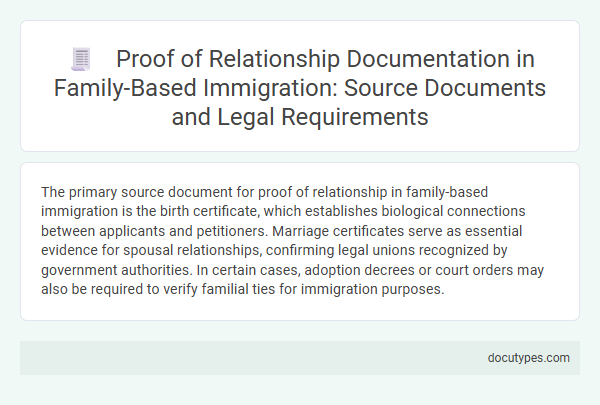The primary source document for proof of relationship in family-based immigration is the birth certificate, which establishes biological connections between applicants and petitioners. Marriage certificates serve as essential evidence for spousal relationships, confirming legal unions recognized by government authorities. In certain cases, adoption decrees or court orders may also be required to verify familial ties for immigration purposes.
Introduction to Proof of Relationship in Family-Based Immigration
In family-based immigration, proving the relationship between the petitioner and the beneficiary is crucial. Immigration authorities require specific source documents to establish this connection clearly and accurately.
Commonly accepted proof of relationship includes marriage certificates, birth certificates, and adoption records. These documents serve as official evidence to validate the familial link in the immigration process.
Legal Basis for Relationship Documentation
| Legal Basis for Relationship Documentation in Family-Based Immigration | |
|---|---|
| Source Document | Primary evidence such as birth certificates, marriage certificates, and adoption decrees establish proof of relationship for family-based immigration petitions. |
| Governing Law | The Immigration and Nationality Act (INA) defines qualifying family relationships and requires documentary proof during petition processing. |
| U.S. Citizenship and Immigration Services (USCIS) | USCIS relies on original or certified copies of civil documents as proof of biological or legal family connections. |
| Document Requirements | Documents must be valid, official, and accompanied by certified English translations if not in English. |
| Additional Evidence | When primary records are unavailable, affidavits, school records, or religious documents may supplement the proof of relationship. |
| Your Role | You must provide accurate and authentic documentation to confirm the family tie that forms the basis of the immigration petition. |
Types of Family Relationships Recognized by Immigration Authorities
Source documents for proof of relationship in family-based immigration vary depending on the type of family relationship. Immigration authorities recognize several categories of family relationships, each requiring specific documentation to establish eligibility.
Common types of family relationships include spouses, parents, children, and siblings. For spouses, a marriage certificate is the primary source document, while birth certificates serve to prove parent-child relationships. Siblings often need to provide birth certificates for both themselves and their common parents to establish the connection.
Primary Source Documents for Proving Family Ties
In family-based immigration, the source document for proof of relationship is crucial to establish the legitimacy of family ties. Primary source documents provide official evidence required by immigration authorities.
Common primary source documents include birth certificates, marriage certificates, and adoption decrees. These documents must clearly demonstrate the biological or legal relationship between the petitioner and beneficiary.
Alternative Evidence When Primary Documents Are Unavailable
Proof of relationship is critical in family-based immigration, typically requiring primary documents like birth or marriage certificates. When these documents are unavailable, alternative evidence can substantiate the familial connection.
- Affidavits from Relatives or Community Members - Sworn statements from individuals who know the family history can support claims of relationship.
- Photographs and Correspondence - Images and letters evidencing ongoing contact demonstrate genuine family ties.
- Official Records and School Documents - Medical records, school reports, and church registrations serve as supplementary proof of relationship.
Common Challenges in Obtaining Relationship Documentation
In family-based immigration, the primary source document for proof of relationship is typically a birth certificate, marriage certificate, or adoption decree. Common challenges in obtaining these documents include inconsistent record-keeping practices, lost or damaged records, and delays caused by bureaucratic procedures. Applicants from countries with limited civil registration systems often face additional hurdles in verifying their familial relationships.
Document Translation and Certification Requirements
What is the source document for proof of relationship in family-based immigration? The primary source document typically includes birth certificates, marriage certificates, or adoption records that establish the familial connection. Translations of these documents must be certified to ensure accuracy and acceptance by immigration authorities.
Affidavits and Secondary Evidence: When and How to Use Them
Proof of relationship is crucial in family-based immigration cases, especially when primary documents are unavailable. Affidavits and secondary evidence serve as alternatives to establish genuine family ties.
- Affidavits - Sworn statements from individuals who can attest to the relationship are used when official documents are missing or insufficient.
- Secondary Evidence - Documents like photos, correspondence, or joint financial records help reinforce the legitimacy of the relationship.
- When to Use - Affidavits and secondary evidence become essential if the primary source document, such as a birth or marriage certificate, cannot be obtained or is unreliable.
Your careful preparation of affidavits and submission of secondary evidence can greatly strengthen your immigration petition.
Tips for Preparing and Submitting Relationship Evidence
In family-based immigration, the primary source document for proof of relationship is typically the birth certificate or marriage certificate, depending on the relationship type. Supporting documents such as photographs, joint financial records, and affidavits from relatives help strengthen your case. Careful organization and clear labeling of these evidence pieces improve the submission process and facilitate verification by immigration officials.
What Is the Source Document for Proof of Relationship in Family-Based Immigration? Infographic

